教学课件 --冀教版中学英语七年级(下) UNIT2 Unit Review
文档属性
| 名称 | 教学课件 --冀教版中学英语七年级(下) UNIT2 Unit Review |
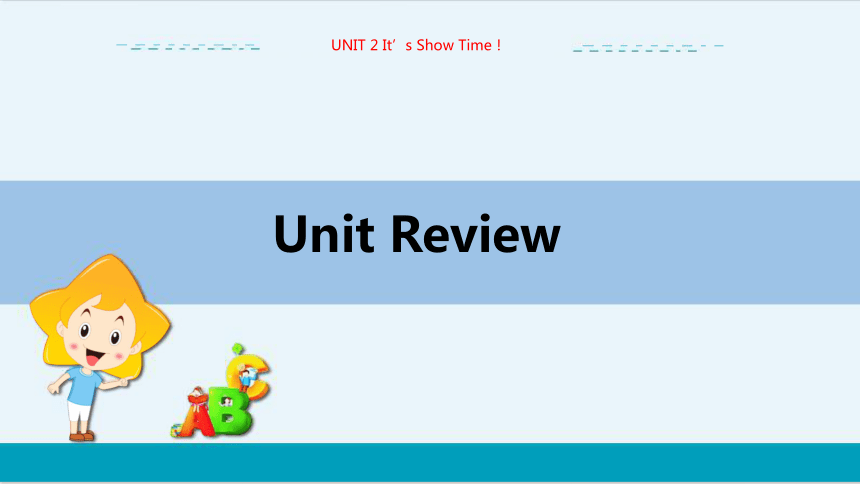
|
|
| 格式 | pptx | ||
| 文件大小 | 11.5MB | ||
| 资源类型 | 试卷 | ||
| 版本资源 | 冀教版 | ||
| 科目 | 英语 | ||
| 更新时间 | 2024-02-21 19:48:23 | ||
图片预览

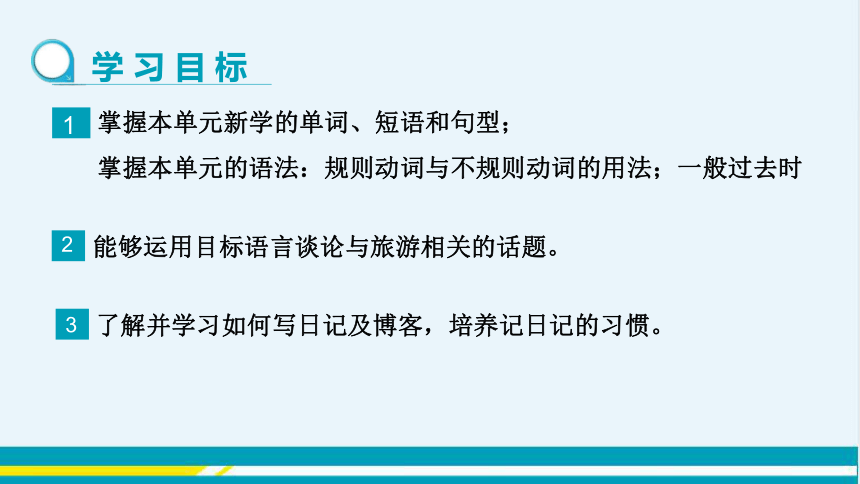
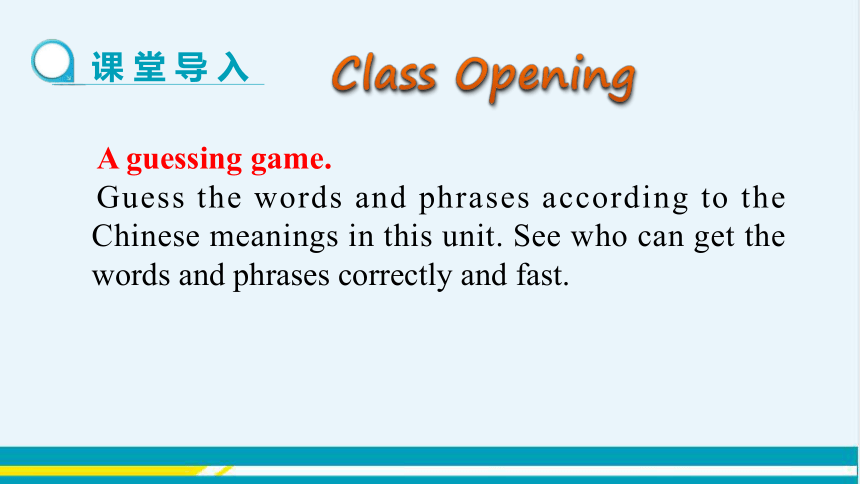
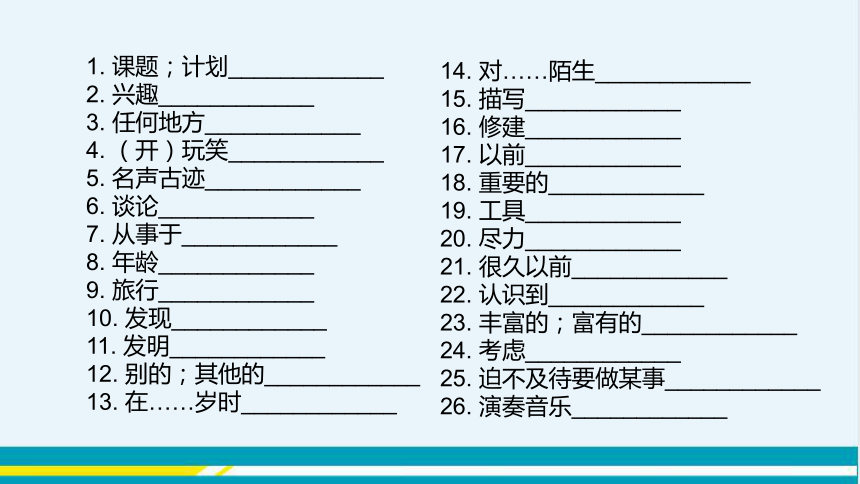
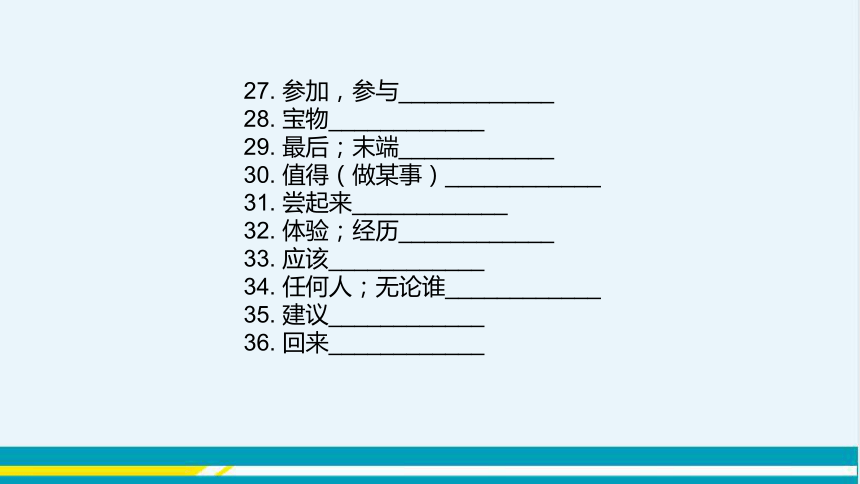

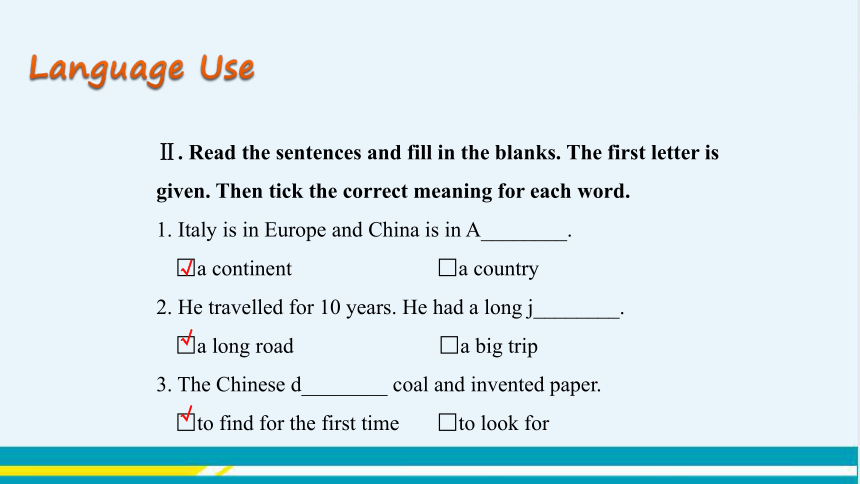
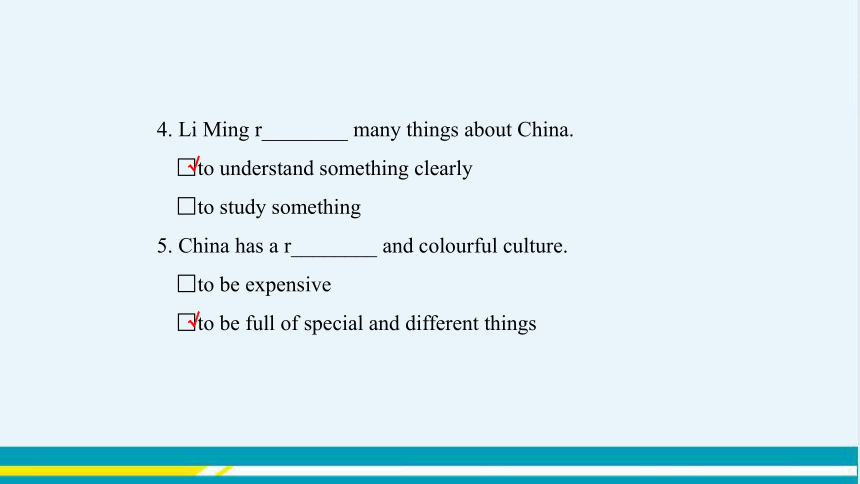
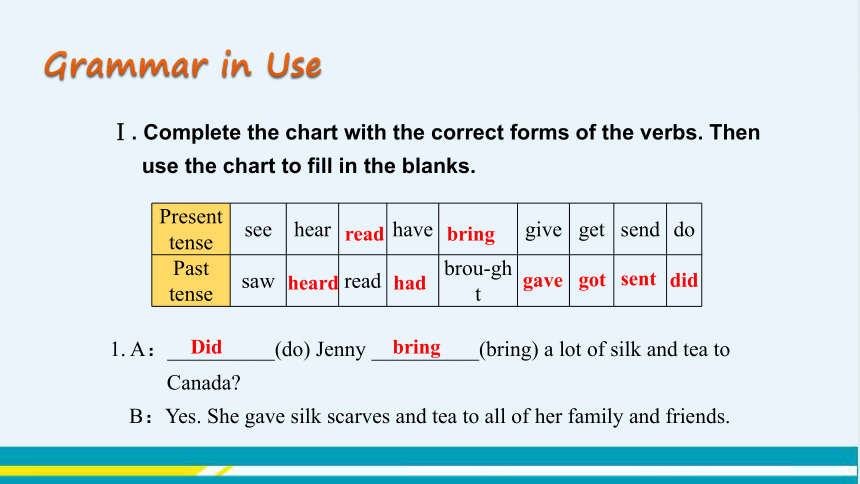
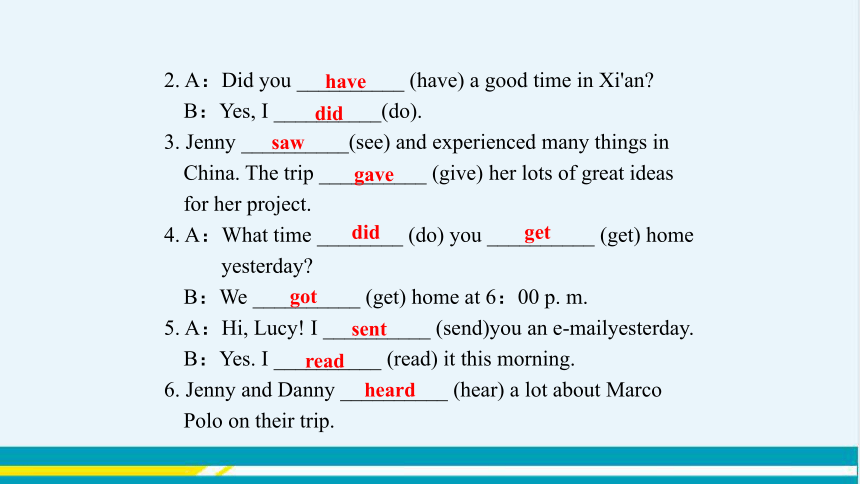
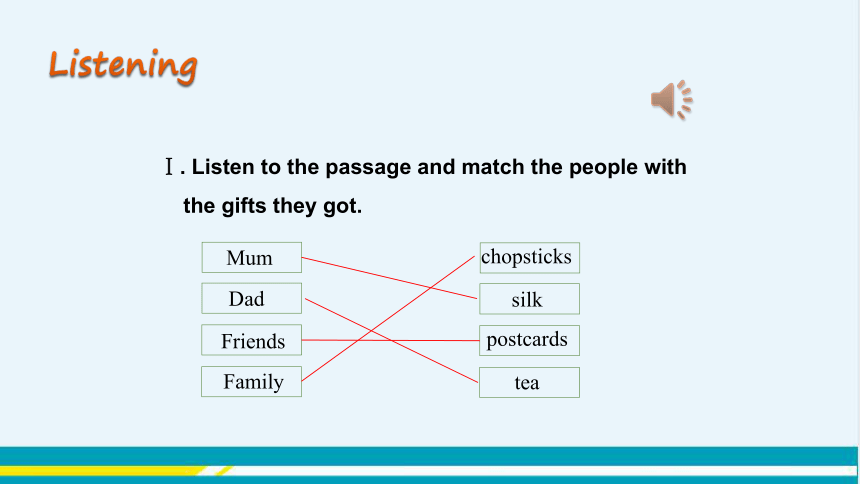
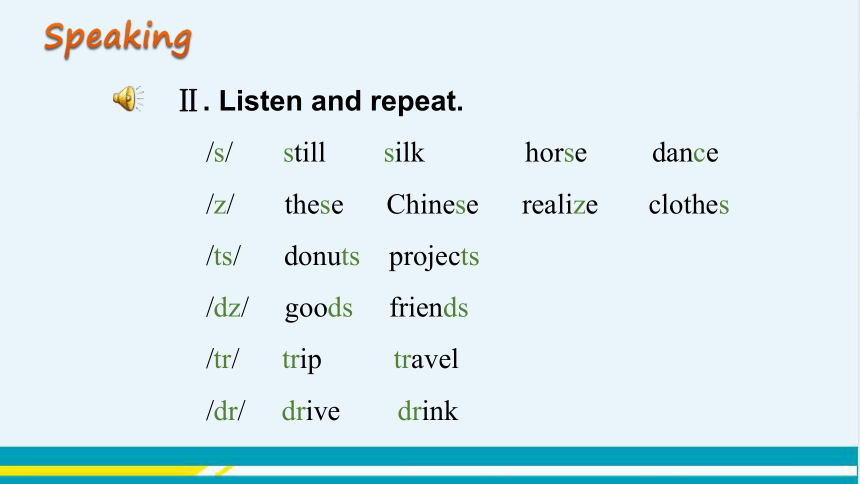
文档简介
(共32张PPT)
Unit Review
UNIT 2 It’s Show Time!
学 习 目 标
掌握本单元新学的单词、短语和句型;
掌握本单元的语法:规则动词与不规则动词的用法;一般过去时
1
3
了解并学习如何写日记及博客,培养记日记的习惯。
能够运用目标语言谈论与旅游相关的话题。
2
课 堂 导 入
Class Opening
A guessing game.
Guess the words and phrases according to the Chinese meanings in this unit. See who can get the words and phrases correctly and fast.
1. 课题;计划____________
2. 兴趣____________
3. 任何地方____________
4. (开)玩笑____________
5. 名声古迹____________
6. 谈论____________
7. 从事于____________
8. 年龄____________
9. 旅行____________
10. 发现____________
11. 发明____________
12. 别的;其他的____________
13. 在……岁时____________
14. 对……陌生____________
15. 描写____________
16. 修建____________
17. 以前____________
18. 重要的____________
19. 工具____________
20. 尽力____________
21. 很久以前____________
22. 认识到____________
23. 丰富的;富有的____________
24. 考虑____________
25. 迫不及待要做某事____________
26. 演奏音乐____________
27. 参加,参与____________
28. 宝物____________
29. 最后;末端____________
30. 值得(做某事)____________
31. 尝起来____________
32. 体验;经历____________
33. 应该____________
34. 任何人;无论谁____________
35. 建议____________
36. 回来____________
Building Your Vocabulary
Ⅰ. Search for words from this unit and fill in the missing letters.
__ ea __ __ z__ exp__ __ ien__ __
j __ __ r __ __y
__ is __ __ __ er
__ o __ l
d __ __ c __ i__ __
s __ i __ __
h __ __ e
d i s c o v e r q w
i m p o r t a n o e
e x p e r i e n c e
h a e r u s a e r c
o s t i l l l a o o
p d e s c r i b e a
e r e a l i z e t l
r o l j o u r n e y
r l i e
e r c e
o u n e
d c o v
c a
e s r b e
t l l
o p
课 堂 学习
Ⅱ. Read the sentences and fill in the blanks. The first letter is given. Then tick the correct meaning for each word.
1. Italy is in Europe and China is in A________.
□a continent □a country
2. He travelled for 10 years. He had a long j________.
□a long road □a big trip
3. The Chinese d________ coal and invented paper.
□to find for the first time □to look for
√
√
√
Language Use
4. Li Ming r________ many things about China.
□to understand something clearly
□to study something
5. China has a r________ and colourful culture.
□to be expensive
□to be full of special and different things
√
√
Ⅰ. Complete the chart with the correct forms of the verbs. Then use the chart to fill in the blanks.
1. A:__________(do) Jenny __________(bring) a lot of silk and tea to Canada
B:Yes. She gave silk scarves and tea to all of her family and friends.
gave
heard
bring
had
read
Grammar in Use
got
Present tense see hear have give get send do
Past tense saw read brou ght
sent
did
Did bring
2. A:Did you __________ (have) a good time in Xi'an
B:Yes, I __________(do).
3. Jenny __________(see) and experienced many things in China. The trip __________ (give) her lots of great ideas for her project.
4. A:What time ________ (do) you __________ (get) home yesterday
B:We __________ (get) home at 6:00 p. m.
5. A:Hi, Lucy! I __________ (send)you an e mailyesterday.
B:Yes. I __________ (read) it this morning.
6. Jenny and Danny __________ (hear) a lot about Marco Polo on their trip.
have
did
saw
gave
did get
got
sent
read
heard
Ⅰ. Listen to the passage and match the people with the gifts they got.
Mum
Dad
Friends
Family
chopsticks
silk
postcards
tea
Listening
Ⅱ. Listen and repeat.
/s/ still silk horse dance
/z/ these Chinese realize clothes
/ts/ donuts projects
/dz/ goods friends
/tr/ trip travel
/dr/ drive drink
Speaking
Everyone travels every day. Think about places you often travel to, such as your home, work and the supermarket. What do you see on the way What is happening around you In groups, make up a dialogue.
A:Why didn't you come to school yesterday
B:Because I had an accident.
A:I'm sorry to hear that.
An Example:
B:Luckily I wasn't badly hurt.
A:Tell us what happened to you.
B:When I crossed the street on the way to school, a black car hit me on the zebra line.
A:Did you go to see a doctor
B:Yes, the man took me to the nearest hospital.
A:What did the doctor do for you
B:He looked over me carefully.
A:What did he say
B:He told me to have a rest at home.
A:Are you feeling better now
B:Much better.
Work in groups. Why do people like to travel What is good about travelling Make a poster about travelling with the title “Why travel?” Include lots of information and pictures. Present your poster to the class.
Task tips:Think about Marco Polo. Why did he travel What did he discover during his travels Think about Ms. Martin and the students. Why did they travel What did they learn about
Putting It All Together
Why travel
Ms. Martin and the students went on a trip to China. They want to learn about China. They visited Xi'an. They saw the Terra Cotta Warriors, the Wild Goose Pagoda and the Yellow River. They learnt the history and culture of China in a new way.
An Example:
Find more examples from this unit. Then mark your stars.
Ⅰ. Praise and Encouragement
Good idea!/ Well done!
__________________________________________
__________________________________________
__________________________________________
I can express praise and encouragement in English.
☆ ☆ ☆ ☆ ☆
Self-Evaluation
Cool pictures,Danny!
Your story is very interesting.
They look good and taste great!
Ⅱ. Regular and Irregular Verbs
work → worked do → did
_____________________________________________
_____________________________________________
_____________________________________________
I can use regular and irregular verbs correctly.
☆ ☆ ☆ ☆ ☆
learn → learned sleep → slept
move → moved hear → heard
last → lasted go → went
Ⅲ. Simple Past Tense
Their journey lasted about twenty years!
_____________________________________________
_____________________________________________
_____________________________________________
I can use the simple past tense properly.
☆ ☆ ☆ ☆ ☆
We had a great trip.
We learned so much.
We heard a lot about him on the Silk Road.
Did you see a funny show
Smile, smile, smile.
Did you see a funny show
Smile, smile, smile.
I'm glad you saw a funny show!
Smile, smile, smile.
Did you watch that lovely dance
Smile, smile, smile.
Smile, Smile, Smile
Sing a song
Did you watch that lovely dance
Smile, smile, smile.
I'm pleased you watched that lovely dance!
Smile, smile, smile!
Did you sing that pretty song
Smile, smile, smile.
Did you sing that pretty song
Smile, smile, smile.
I'm happy you sang that pretty song!
Smile, smile, smile.
动词的过去式
规则动词的过去式的构成
规则动词的过去式的变化规则 1.直接加-ed。 eg:look—looked
watch—watched
2.以不发音的字母 e结尾的 动词直接加 d。 eg: like—liked
move—moved
3.以辅音字母加 y结尾的动 词,变-y为 i,再加-ed。 eg: study—studied
cry—cried
4.末尾只有一个辅音字母的 重读闭音节单词,先双写 这个辅音字母再加-ed。 eg:shop—shopped
stop—stopped
Grammar
不规则动词的过去式,需要特别记忆:
have—had;are—were;get—got;say—said
feel—felt;do/does—did;is—was;go—went
drink—drank;eat—ate;bring—brought
think—thought;buy—bought;catch—caught
teach—taught;sit—sat;wear—wore
cut—cut;sleep—slept;become—became等。
一、一般过去时的基本概念
一般过去时表示过去某个时间里发生的动作或存在的状态;过去习惯性、经常性的动作或行为;过去主语所具备的能力或性格。
二、一般过去时的构成形式
(1)肯定句:
①主语+谓语(动词过去式)+其他.
②主语+was/were+其他.
一般过去时
(2)否定句:
①主语+was/were+not+其他.
②主语+didn't+谓语(动词原形)+其他.
(3)一般疑问句:
①Did+主语+谓语(动词原形)+其他?
②Was/Were+主语+其他?
例:She often came to help us in those days.
那些日子里她经常来帮助我们。
He was a teacher two years ago.
他两年前是一名教师。
I didn't know your name.
我不知道你的名字。
They were not rich at that time.
他们那时并不富裕。
Did you finish your homework?
你做完家庭作业了吗?
Were you happy during the school trip?
你在学校旅行期间开心吗?
三、一般过去时的用法
1.一般过去时既可表示在过去某个特定的时间发
生的动作,也可表示过去习惯性、经常性的动作。
一般不强调动作的影响,只说明事情。
例:I talked with Julia this morning.
今天早晨,我跟朱莉娅谈了话。
2.一般过去时常与表示过去的时间状语或从句连用。
例:yesterday、last week、in the past、in 1993、
at that time、once、during the war、before、when等。
注意:在谈到已去世的人的情况时,多用一般过去时。
例:He died in 1990. 他是在1990年去世的。
3.表示过去连续发生的动作,要用一般过去时。这种情况下,往往没有表示过去的时间状语,而是通过上下文来判断。
例:The boy opened his eyes for a moment,
looked at the captain,and then died. 那个男孩把
眼睛睁开了一会儿,看了看船长,然后就死去了。
Summary
1. 一般过去时。
2. 谈论旅游过程。
3. 本单元的生词及交际用语。
用所给词的适当形式填空
1.—________your mother________(make) dumplings last night
—Yes,she did. She________(make) them for us.
2.—Where________ Danny________ (take) this picture
—He________(take) this picture in Xi’an.
3.—Where did she________(find) the book
—She________(find) it in the library.
4.—________she________(practice) her guitar yesterday
—No,she didn’t.
took
made
find
Did
did
found
make
take
课 堂 达 标
Did
practice
Remember the new words and expressions learnt in UNIT 2.
2. Review Simple Past Tense.
Homework
Thank you !
Unit Review
UNIT 2 It’s Show Time!
学 习 目 标
掌握本单元新学的单词、短语和句型;
掌握本单元的语法:规则动词与不规则动词的用法;一般过去时
1
3
了解并学习如何写日记及博客,培养记日记的习惯。
能够运用目标语言谈论与旅游相关的话题。
2
课 堂 导 入
Class Opening
A guessing game.
Guess the words and phrases according to the Chinese meanings in this unit. See who can get the words and phrases correctly and fast.
1. 课题;计划____________
2. 兴趣____________
3. 任何地方____________
4. (开)玩笑____________
5. 名声古迹____________
6. 谈论____________
7. 从事于____________
8. 年龄____________
9. 旅行____________
10. 发现____________
11. 发明____________
12. 别的;其他的____________
13. 在……岁时____________
14. 对……陌生____________
15. 描写____________
16. 修建____________
17. 以前____________
18. 重要的____________
19. 工具____________
20. 尽力____________
21. 很久以前____________
22. 认识到____________
23. 丰富的;富有的____________
24. 考虑____________
25. 迫不及待要做某事____________
26. 演奏音乐____________
27. 参加,参与____________
28. 宝物____________
29. 最后;末端____________
30. 值得(做某事)____________
31. 尝起来____________
32. 体验;经历____________
33. 应该____________
34. 任何人;无论谁____________
35. 建议____________
36. 回来____________
Building Your Vocabulary
Ⅰ. Search for words from this unit and fill in the missing letters.
__ ea __ __ z__ exp__ __ ien__ __
j __ __ r __ __y
__ is __ __ __ er
__ o __ l
d __ __ c __ i__ __
s __ i __ __
h __ __ e
d i s c o v e r q w
i m p o r t a n o e
e x p e r i e n c e
h a e r u s a e r c
o s t i l l l a o o
p d e s c r i b e a
e r e a l i z e t l
r o l j o u r n e y
r l i e
e r c e
o u n e
d c o v
c a
e s r b e
t l l
o p
课 堂 学习
Ⅱ. Read the sentences and fill in the blanks. The first letter is given. Then tick the correct meaning for each word.
1. Italy is in Europe and China is in A________.
□a continent □a country
2. He travelled for 10 years. He had a long j________.
□a long road □a big trip
3. The Chinese d________ coal and invented paper.
□to find for the first time □to look for
√
√
√
Language Use
4. Li Ming r________ many things about China.
□to understand something clearly
□to study something
5. China has a r________ and colourful culture.
□to be expensive
□to be full of special and different things
√
√
Ⅰ. Complete the chart with the correct forms of the verbs. Then use the chart to fill in the blanks.
1. A:__________(do) Jenny __________(bring) a lot of silk and tea to Canada
B:Yes. She gave silk scarves and tea to all of her family and friends.
gave
heard
bring
had
read
Grammar in Use
got
Present tense see hear have give get send do
Past tense saw read brou ght
sent
did
Did bring
2. A:Did you __________ (have) a good time in Xi'an
B:Yes, I __________(do).
3. Jenny __________(see) and experienced many things in China. The trip __________ (give) her lots of great ideas for her project.
4. A:What time ________ (do) you __________ (get) home yesterday
B:We __________ (get) home at 6:00 p. m.
5. A:Hi, Lucy! I __________ (send)you an e mailyesterday.
B:Yes. I __________ (read) it this morning.
6. Jenny and Danny __________ (hear) a lot about Marco Polo on their trip.
have
did
saw
gave
did get
got
sent
read
heard
Ⅰ. Listen to the passage and match the people with the gifts they got.
Mum
Dad
Friends
Family
chopsticks
silk
postcards
tea
Listening
Ⅱ. Listen and repeat.
/s/ still silk horse dance
/z/ these Chinese realize clothes
/ts/ donuts projects
/dz/ goods friends
/tr/ trip travel
/dr/ drive drink
Speaking
Everyone travels every day. Think about places you often travel to, such as your home, work and the supermarket. What do you see on the way What is happening around you In groups, make up a dialogue.
A:Why didn't you come to school yesterday
B:Because I had an accident.
A:I'm sorry to hear that.
An Example:
B:Luckily I wasn't badly hurt.
A:Tell us what happened to you.
B:When I crossed the street on the way to school, a black car hit me on the zebra line.
A:Did you go to see a doctor
B:Yes, the man took me to the nearest hospital.
A:What did the doctor do for you
B:He looked over me carefully.
A:What did he say
B:He told me to have a rest at home.
A:Are you feeling better now
B:Much better.
Work in groups. Why do people like to travel What is good about travelling Make a poster about travelling with the title “Why travel?” Include lots of information and pictures. Present your poster to the class.
Task tips:Think about Marco Polo. Why did he travel What did he discover during his travels Think about Ms. Martin and the students. Why did they travel What did they learn about
Putting It All Together
Why travel
Ms. Martin and the students went on a trip to China. They want to learn about China. They visited Xi'an. They saw the Terra Cotta Warriors, the Wild Goose Pagoda and the Yellow River. They learnt the history and culture of China in a new way.
An Example:
Find more examples from this unit. Then mark your stars.
Ⅰ. Praise and Encouragement
Good idea!/ Well done!
__________________________________________
__________________________________________
__________________________________________
I can express praise and encouragement in English.
☆ ☆ ☆ ☆ ☆
Self-Evaluation
Cool pictures,Danny!
Your story is very interesting.
They look good and taste great!
Ⅱ. Regular and Irregular Verbs
work → worked do → did
_____________________________________________
_____________________________________________
_____________________________________________
I can use regular and irregular verbs correctly.
☆ ☆ ☆ ☆ ☆
learn → learned sleep → slept
move → moved hear → heard
last → lasted go → went
Ⅲ. Simple Past Tense
Their journey lasted about twenty years!
_____________________________________________
_____________________________________________
_____________________________________________
I can use the simple past tense properly.
☆ ☆ ☆ ☆ ☆
We had a great trip.
We learned so much.
We heard a lot about him on the Silk Road.
Did you see a funny show
Smile, smile, smile.
Did you see a funny show
Smile, smile, smile.
I'm glad you saw a funny show!
Smile, smile, smile.
Did you watch that lovely dance
Smile, smile, smile.
Smile, Smile, Smile
Sing a song
Did you watch that lovely dance
Smile, smile, smile.
I'm pleased you watched that lovely dance!
Smile, smile, smile!
Did you sing that pretty song
Smile, smile, smile.
Did you sing that pretty song
Smile, smile, smile.
I'm happy you sang that pretty song!
Smile, smile, smile.
动词的过去式
规则动词的过去式的构成
规则动词的过去式的变化规则 1.直接加-ed。 eg:look—looked
watch—watched
2.以不发音的字母 e结尾的 动词直接加 d。 eg: like—liked
move—moved
3.以辅音字母加 y结尾的动 词,变-y为 i,再加-ed。 eg: study—studied
cry—cried
4.末尾只有一个辅音字母的 重读闭音节单词,先双写 这个辅音字母再加-ed。 eg:shop—shopped
stop—stopped
Grammar
不规则动词的过去式,需要特别记忆:
have—had;are—were;get—got;say—said
feel—felt;do/does—did;is—was;go—went
drink—drank;eat—ate;bring—brought
think—thought;buy—bought;catch—caught
teach—taught;sit—sat;wear—wore
cut—cut;sleep—slept;become—became等。
一、一般过去时的基本概念
一般过去时表示过去某个时间里发生的动作或存在的状态;过去习惯性、经常性的动作或行为;过去主语所具备的能力或性格。
二、一般过去时的构成形式
(1)肯定句:
①主语+谓语(动词过去式)+其他.
②主语+was/were+其他.
一般过去时
(2)否定句:
①主语+was/were+not+其他.
②主语+didn't+谓语(动词原形)+其他.
(3)一般疑问句:
①Did+主语+谓语(动词原形)+其他?
②Was/Were+主语+其他?
例:She often came to help us in those days.
那些日子里她经常来帮助我们。
He was a teacher two years ago.
他两年前是一名教师。
I didn't know your name.
我不知道你的名字。
They were not rich at that time.
他们那时并不富裕。
Did you finish your homework?
你做完家庭作业了吗?
Were you happy during the school trip?
你在学校旅行期间开心吗?
三、一般过去时的用法
1.一般过去时既可表示在过去某个特定的时间发
生的动作,也可表示过去习惯性、经常性的动作。
一般不强调动作的影响,只说明事情。
例:I talked with Julia this morning.
今天早晨,我跟朱莉娅谈了话。
2.一般过去时常与表示过去的时间状语或从句连用。
例:yesterday、last week、in the past、in 1993、
at that time、once、during the war、before、when等。
注意:在谈到已去世的人的情况时,多用一般过去时。
例:He died in 1990. 他是在1990年去世的。
3.表示过去连续发生的动作,要用一般过去时。这种情况下,往往没有表示过去的时间状语,而是通过上下文来判断。
例:The boy opened his eyes for a moment,
looked at the captain,and then died. 那个男孩把
眼睛睁开了一会儿,看了看船长,然后就死去了。
Summary
1. 一般过去时。
2. 谈论旅游过程。
3. 本单元的生词及交际用语。
用所给词的适当形式填空
1.—________your mother________(make) dumplings last night
—Yes,she did. She________(make) them for us.
2.—Where________ Danny________ (take) this picture
—He________(take) this picture in Xi’an.
3.—Where did she________(find) the book
—She________(find) it in the library.
4.—________she________(practice) her guitar yesterday
—No,she didn’t.
took
made
find
Did
did
found
make
take
课 堂 达 标
Did
practice
Remember the new words and expressions learnt in UNIT 2.
2. Review Simple Past Tense.
Homework
Thank you !
同课章节目录
- Unit 1 A Trip to the Silk Road
- Lesson 1 A Trip to China
- Lesson 2 Meet You in Beijing
- Lesson 3 A Visit to Xi'an
- Lesson 4 A Visit to Lanzhou
- Lesson 5 Another Stop along the Silk Road
- Lesson 6 Jenny's Diary
- Unit 2 It's Show Time!
- Lesson 7 What's Your Project about?
- Lesson 8 Marco Polo and the Silk Road
- Lesson 9 Danny's School Project
- Lesson 10 Music and Dance
- Lesson 11 Food in China
- Lesson 12 A Blog about the Silk Road
- Unit 3 School Life
- Lesson 13 How Is School Going?
- Lesson 14 Jenny's School Life
- Lesson 15 Making a Difference
- Lesson 16 We Are with You!
- Lesson 17 School Science Fai
- Lesson 18 Teaching in China
- Unit 4 After-School Activities
- Lesson 19 A Dinner Date
- Lesson 20 Join Our Club!
- Lesson 21 What Is Your Club Type?
- Lesson 22 Big Plans for the Weekend
- Lesson 23 A Weekend with Grandma
- Lesson 24 How was Your Weekend?
- Unit 5 I Love Learning English!
- Lesson 25 A Phone Friend
- Lesson 26 Online Phone Calls
- Lesson 27 Amazing English
- Lesson 28 How Do I Learn English?
- Lesson 29 A Door to the World
- Lesson 30 Writing an E-mail in English
- Unit 6 Seasons
- Lesson 31 What Strange Weather!
- Lesson 32 I Can't Wait for Winter!
- Lesson 33 Kim's Favourite Season
- Lesson 34 Steven's Report
- Lesson 35 Surfing in Sydney
- Lesson 36 Spring in China
- Unit 7 Sports and Good Health
- Lesson 37 You Are What You Eat!
- Lesson 38 Stay Healthy!
- Lesson 39 Danny's Report
- Lesson 40 Move Your Body
- Lesson 41 Were People Healthy Then?
- Lesson 42 Know Yourself
- Unit 8 Summer Holiday Is Coming!
- Lesson 43 Have a Good Summer!
- Lesson 44 Volunteering in Summe
- Lesson 45 Baseball Season
- Lesson 46 Get Ready for Summer Holiday!
- Lesson 47 Summer Plans
- Lesson 48 Li Ming's Summer Holiday
